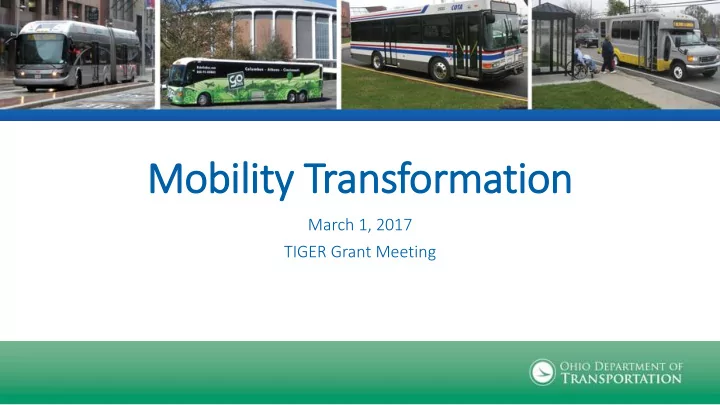

Mobility Transformation March 1, 2017 TIGER Grant Meeting
Introduction 2
Historical Perspective • Transit needs study identified a need for increased coordination • “What we have is transportation collaboration – not actual coordination ” • Barriers to coordination • Technology • State Level Policy • Support for local coordinated planning
Problems Statement • Currently, Health and Human Service Transportation is; • Provided in a fragmented and inefficient manner • Administered through 14 state agencies. • Costing Ohio over $500 million annually
Mobility Transformation Medicaid Ohio Administrative ODJFS Code Single Policy Ohio Agency Revised Policies Aging Code DODD Examine Individual Identify what can be Work Together to Form Agency Policy changed Recommendations
ODOT’s Role • ODOT’s Value Added • Transportation Experience • Working Relationship with Public Transit • Access to Transportation Grants for statewide initiatives
Goals and Priorities for Public Transit Easier to work Level Playing Access to Rides with HSS Agencies Field • Work with more • All providers at • Consumers can agencies same standards choose transit • Easier to • Requirements • Referrals for become are standardized rides provider • Shared ride becomes a possibility
Mobility Transformation – General Benefits Increased Greater Increased Access for More providers Efficiency – Quality Control Consumers Reduced Waste
What is a “Coordinated Plan”? • Locally Developed, Coordinated Public Transit-Human Service Transportation Plan a.k.a Coordinated Plan • Originally enacted with SAFETEA-LU in 2007 as a condition of Federal Assistance • Exists to expand service coverage and availability by bringing together federal, state and local transportation resources to minimize duplication of services. • Section 5310: Enhanced Mobility of Seniors and Individuals with Disabilities is the only federal program that currently requires a coordinated plan.
What are the goals of this initiative? • Achieve statewide coverage of plans • Standardize what’s included in a Coordinated Plan • Reduce effort required to institute Coordinated Plans • More equitable and efficient allocation of funding • Support ODOT’s vision of a regional transportation planning and delivery
Where are we now? • Coordinated plans currently vary in age, structure and content. • Lack of consistency makes it difficult to select projects and ensure objectives and strategies are current and being achieved • Plans are mainly used for the acquisition of Section 5310 funding
Where are we going? • ODOT is currently working with a consultant, RLS & Associates, to develop a Coordinated Plan Template, Guidance and Toolkit for entities with existing coordinated plans as well as entities interested in forming a coordinated plan • Template – Used to draft coordinated plan for ODOT – acceptance • Guidance – Instructions for creating and maintaining a coordinated plan and how to ensure compliance with State and Federal regulations • Toolkit – Helpful tools to assist entities as they develop coordinated plans • i.e. – best practices for public involvement, reputable sources for data collection, draft surveys, etc. • Target date for distribution of April, 2017
MPO/ RTPO Regions
How can you help achieve these goals? • Be active and engaged coordination partners in your community! • Work to identify regions
Recommend
More recommend